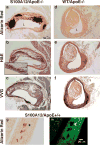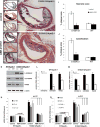S100A12 and the S100/Calgranulins: Emerging Biomarkers for Atherosclerosis and Possibly Therapeutic Targets
- PMID: 26515415
- PMCID: PMC4771489
- DOI: 10.1161/ATVBAHA.115.302072
S100A12 and the S100/Calgranulins: Emerging Biomarkers for Atherosclerosis and Possibly Therapeutic Targets
Abstract
Atherosclerosis is mediated by local and systematic inflammation. The multiligand receptor for advanced glycation end products (RAGE) has been studied in animals and humans and is an important mediator of inflammation and atherosclerosis. This review focuses on S100/calgranulin proteins (S100A8, S100A9, and S100A12) and their receptor RAGE in mediating vascular inflammation. Mice lack the gene for S100A12, which in humans is located on chromosome 3 between S100A8 and S100A9. Transgenic mice with smooth muscle cell-targeted expression of S100A12 demonstrate increased coronary and aortic calcification, as well as increased plaque vulnerability. Serum S100A12 has recently been shown to predict future cardiovascular events in a longitudinal population study, underscoring a role for S100A12 as a potential biomarker for coronary artery disease. Genetic ablation of S100A9 or RAGE in atherosclerosis-susceptible apolipoprotein E null mice results in reduced atherosclerosis. Importantly, S100A12 and the RAGE axis can be modified pharmacologically. For example, soluble RAGE reduces murine atherosclerosis and vascular inflammation. Additionally, a class of compounds currently in phase III clinical trials for multiple sclerosis and rheumatologic conditions, the quinoline-3-carboxamides, reduce atherosclerotic plaque burden and complexity in transgenic S100A12 apolipoprotein E null mice, but have not been tested with regards to human atherosclerosis. The RAGE axis is an important mediator for inflammation-induced atherosclerosis, and S100A12 has emerged as biomarker for human atherosclerosis. Decreasing inflammation by inhibiting S100/calgranulin-mediated activation of RAGE attenuates murine atherosclerosis, and future studies in patients with coronary artery disease are warranted to confirm S100/RAGE as therapeutic target for atherosclerosis.
Keywords: S100/calgranulins; S100A12; apolipoprotein E; atherosclerosis; coronary artery disease; inflammation.
© 2015 American Heart Association, Inc.
Figures




Similar articles
-
Discerning the promising binding sites of S100/calgranulins and their therapeutic potential in atherosclerosis.Expert Opin Ther Pat. 2021 Nov;31(11):1045-1057. doi: 10.1080/13543776.2021.1937122. Epub 2021 Jun 10. Expert Opin Ther Pat. 2021. PMID: 34056993 Free PMC article. Review.
-
S100/Calgranulin-mediated inflammation accelerates left ventricular hypertrophy and aortic valve sclerosis in chronic kidney disease in a receptor for advanced glycation end products-dependent manner.Arterioscler Thromb Vasc Biol. 2014 Jul;34(7):1399-411. doi: 10.1161/ATVBAHA.114.303508. Epub 2014 May 22. Arterioscler Thromb Vasc Biol. 2014. PMID: 24855059 Free PMC article.
-
Beneficial effects of quinoline-3-carboxamide (ABR-215757) on atherosclerotic plaque morphology in S100A12 transgenic ApoE null mice.Atherosclerosis. 2013 May;228(1):69-79. doi: 10.1016/j.atherosclerosis.2013.02.023. Epub 2013 Feb 28. Atherosclerosis. 2013. PMID: 23497784 Free PMC article.
-
Blocking the interaction between S100A9 protein and RAGE V domain using S100A12 protein.PLoS One. 2018 Jun 14;13(6):e0198767. doi: 10.1371/journal.pone.0198767. eCollection 2018. PLoS One. 2018. PMID: 29902210 Free PMC article.
-
S100 proteins in atherosclerosis.Clin Chim Acta. 2020 Mar;502:293-304. doi: 10.1016/j.cca.2019.11.019. Epub 2019 Nov 30. Clin Chim Acta. 2020. PMID: 31794767 Review.
Cited by
-
HMGB1, IL-1α, IL-33 and S100 proteins: dual-function alarmins.Cell Mol Immunol. 2017 Jan;14(1):43-64. doi: 10.1038/cmi.2016.34. Epub 2016 Aug 29. Cell Mol Immunol. 2017. PMID: 27569562 Free PMC article. Review.
-
Effect of Vitamin D Receptor Activation on the AGE/RAGE System and Myeloperoxidase in Chronic Kidney Disease Patients.Oxid Med Cell Longev. 2017;2017:2801324. doi: 10.1155/2017/2801324. Epub 2017 Dec 6. Oxid Med Cell Longev. 2017. PMID: 29362665 Free PMC article. Clinical Trial.
-
The Features of Shared Genes among Transcriptomes Probed in Atopic Dermatitis, Psoriasis, and Inflammatory Acne: S100A9 Selection as the Target Gene.Protein Pept Lett. 2024;31(5):356-374. doi: 10.2174/0109298665290166240426072642. Protein Pept Lett. 2024. PMID: 38766834
-
Discerning the promising binding sites of S100/calgranulins and their therapeutic potential in atherosclerosis.Expert Opin Ther Pat. 2021 Nov;31(11):1045-1057. doi: 10.1080/13543776.2021.1937122. Epub 2021 Jun 10. Expert Opin Ther Pat. 2021. PMID: 34056993 Free PMC article. Review.
-
Arterial Calcification in Diabetes Mellitus: Preclinical Models and Translational Implications.Arterioscler Thromb Vasc Biol. 2017 Feb;37(2):205-217. doi: 10.1161/ATVBAHA.116.306258. Epub 2016 Dec 22. Arterioscler Thromb Vasc Biol. 2017. PMID: 28062508 Free PMC article. Review.
References
-
- Mendis S, Davis S, Norrving B. Organizational update: the world health organization global status Report on noncommunicable Diseases 2014; one more landmark step in the combat against stroke and vascular disease. Stroke. 2015;46(5):121–122. - PubMed
-
- Danesh J, Wheeler JG, Hirschfield GM, Eda S, Eiriksdottir G, Rumley A, Lowe GD, Pepys MB, Gudnason V. C-Reactive Protein and Other Circulating Markers of Inflammation in the Prediction of Coronary Heart Disease. N Engl J Med. 2004;350:1387–1397. - PubMed
Publication types
MeSH terms
Substances
Grants and funding
LinkOut - more resources
Full Text Sources
Medical
Research Materials
Miscellaneous

